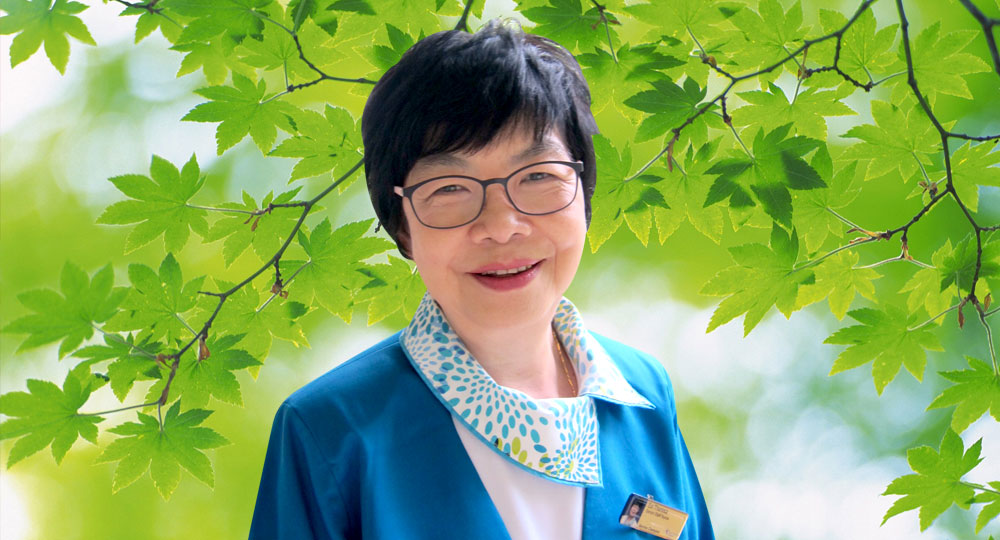
AS A child, Madam Theresa Ee wanted to be a teacher. But a family crisis changed her life’s direction when she was 16.
Her father fell critically ill and had to be rushed to the hospital. “He suddenly vomited lots of blood and went into shock. He had to be resuscitated in the hospital and then have an emergency gastrectomy. This was followed by a three-week stay in hospital,” recalled Madam Ee.
During his hospitalisation, she saw how the nurses cared for her father – who passed on in 1998 at the ripe old age of 90 – with professionalism, dedication and kindness. “It was my experience with this special group of nurses that changed my ambition from being a teacher to a nurse,” she said.
Today, Madam Ee is a Senior Staff Nurse with Khoo Teck Puat Hospital (KTPH), and works as a Diabetes Nurse Educator and a Point-of-Care Testing Nurse Trainer.
She educates diabetes patients on preventing acute complications such as hypoglycaemia (low blood sugar) and hyperglycaemia (high blood sugar), as well as long-term complications which may include vision loss, kidney failure and loss of the lower limbs. Madam Ee also trains new nurses to perform blood glucose testing.
Having been a nurse for over four decades, Madam Ee has seen how nursing has evolved.
“I remember 40 years ago we had to wash, starch, sun and then iron our white caps and white uniforms. Our shoes and socks had to be sparkling white as well. Now, these have been replaced with coloured uniforms with different designs,” she said, with a chuckle.
Testing patients’ urine for sugar levels also has come a long way.
Madam Ee explained: “The nurse would pipette 5mls (one teaspoon) of Benedict’s solution (a chemical mixture used to detect the presence of sugar) into a glass test tube. The solution would be heated to boil.
“Then eight drops of the patient’s urine would be mixed well with the solution, before boiling again. Sometimes, the heated contents would spurt out! Upon cooling, the presence of sugar would be indicated by colours ranging from blue (meaning an absence of sugar) to green, yellow, orange and red (indicating sugar level of 2% or more).”
Now, technology has made it possible for a patient’s blood glucose level to be tested electronically and the results wirelessly transferred to the hospital system. “These days, nurses are blessed with well-serviced equipment and devices. And there are more learning and career opportunities to broaden their knowledge and improve their skills,” said Madam Ee.
It wasn’t all about uniforms and technology though. Madam Ee remembers an incident that went beyond medical boundaries during her time at Alexandra Hospital in the mid-1990s.
A patient, hospitalised for severe diarrhoea, could not speak much but responded to her care with smiles, a few words or two thumbs up. His wife was a patient at Woodbridge Hospital (now known as the Institute of Mental Health) and they had three sons.
One day, one of the sons told the doctor that he wanted his father to sell his house – a very valuable property – so the proceeds could be used to care for his parents. When the patient found out, he wept bitterly.
“I immediately spoke to the doctor and told him very clearly that the son was out to cheat his father as he did not visit him at all during his stay in the hospital!” recalled Madam Ee.
Thanks to her quick thinking, a potential crisis was averted. Though the house was eventually sold, the proceeds were managed carefully and channelled to the long-term care of the patient and his wife.
When Madam Ee next visited the patient, he was all smiles. “My husband and I knew he liked bananas so we bought him some. He showed me two thumbs up as a gesture of gratitude,” she shared.
As a Diabetes Nurse Educator today, Madam Ee is happy when her patients make lifestyle changes, especially in their diet and level of physical activity, and do their best to keep their diabetes in check.
In her free time, she spends a lot of time with her family. She also teaches Bible classes to the young children at her church and is involved with the Inter-Racial and Religious Confidence Circle.
What advice does Madam Ee have for the young and young at heart?
“Pick up good habits from young, so that even when you’re old, your good habits will not leave you. Young ones should start by helping out at home and in school, learning from people and also improving their relationships with others, to build bonds,” she said.
The way Madam Ee sees it, seniors can only age gracefully and healthily when they take the time to build relationships with their families, neighbours and communities: “Active ageing, I realise, is really about interdependence as well as intergenerational support. Get to know your own family and friends. Then, slowly get to know your neighbours living opposite you. Be humble to learn new things like technology from the younger ones.”
Then, sounding almost like an endorsement for successful ageing, she added: “There is no short cut to active ageing.”
This story is part of an 'Everyday Heroes' series. To read our previous story featuring Senior Staff Nurse Yuen Mei Choy, an Obstetrics & Gynaecology (O&G) nurse from National University Hospital, click here.
Article published on: 16/8/2016